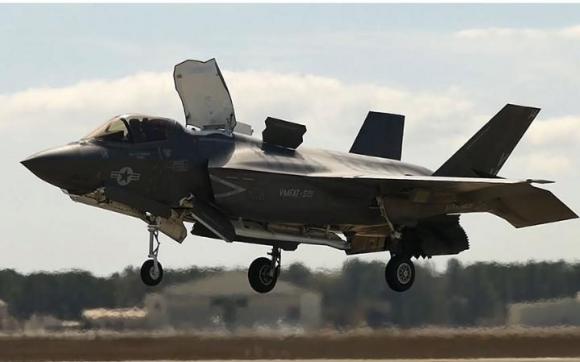The Marine Corps has started an internal investigation to find out the causes of a fire that developed in the weapons hold of an F-35B during a training mission on Beaufort, South Carolina, the 27 last October.
In a note of the 2nd Marine Aircraft Wing, it states that "the aircraft landed safely, both the pilot and the ground personnel were unharmed. An investigation is in progress, we will provide details when available ".
The amount of damage, classified as category A, would exceed two million dollars. Class A is also applicable for accidents involving the death of airline personnel.
The F-35B are currently deployed with both the Marine Fighter Attack Training Squadron 501 and the Marine Fighter Attack Squadron 121, in Yuma, Arizona. The tests also continue regularly on the USS America.
The 2014 fire
On June 23, 2014, the pilot of an Air Force F-35A assigned to the 58th Fighter Squadron at Eglin Air Base, Florida, was forced to abort take-off "safely aborted the takeoff". safe) and abandon the aircraft due to a fire that was now spreading on the fighter. The pilot remained unharmed, but the incident resulted in the grounding of the entire F-35 fleet for a short time, the cancellation of the Marine's F-35B presentation at the Farnborough Airshow, England, and a series of new tests on the propulsion system. The cause of the fire that engulfed the F-35A, tail number 10-5015, was confirmed by the Air Education and Training Command. The cause of the fire was a problem in the third stage of the engine module. An excessive friction (“hard rub”) condition would have occurred between the engine turbine blades and the surrounding grille. The excessive overheating then shattered part of the rotor section located in the third stage of the Pratt & Whitney F135 propulsion system module.
The loose chips (we must consider the timing, the problem occurred within microseconds) were sucked into the entire propulsion line, damaging the internal fuel tank and the hydraulics. The wreckage of the shattered rotor then pierced the top of the aircraft fuselage. The fire developed due to the loss of fuel and hydraulic oil. The flames wrapped two thirds of the aircraft. The F-35A cell, which cost just over 2013 million dollars in the 100, reported damage for 50 million dollars. As confirmed by Lockheed, the engine problem would not be systemic.
The 23 fire last September
On September 23, an F-35A caught fire during a drill at Mountain Home Air Force Base, Idaho. The incident involved an F-35A from the 61st Fighter Squadron stationed at Luke Air Force Base. There were no injuries, the fire was quickly put out. The Air Force immediately opened an investigation to establish the nature of the accident. The F135 engine produced by Pratt & Whitney of the F-35 is under observation. Finally, it is unknown whether the fire could be related to the problem of the faulty insulation that has already grounded fifteen operational aircraft and that affects another 42 F-35s on the production line.
The first fighters treated with defective insulation, have resumed flying last week. The defective insulation was used only in the model A of the F-35. No problems for versions B and C. The JPO (Joint Program Office) reiterates the manufacturing defect and not a technical problem that could affect the performance of the aircraft. On the 42 F-35A production line in Fort Worth, Texas, the defective insulation was already used.
(Photo: DoD)












